Quick test: Can you spot the error in this sentence?
“The cat chased it’s tail while the children played with there toys in our’s backyard.”
If you found all three mistakes, congratulations you already have a grip on possessive determiners — the topic which we’re covering today.
If not, don’t worry.
You’re about to learn everything about possessive determiners.
Most people think they know what are the possessive determiners, but when pressed to explain what do possessive determiners do or list what are 5 examples of possessive determiners, they stumble.
But to ensure that’s not you, we’ve created this blog.
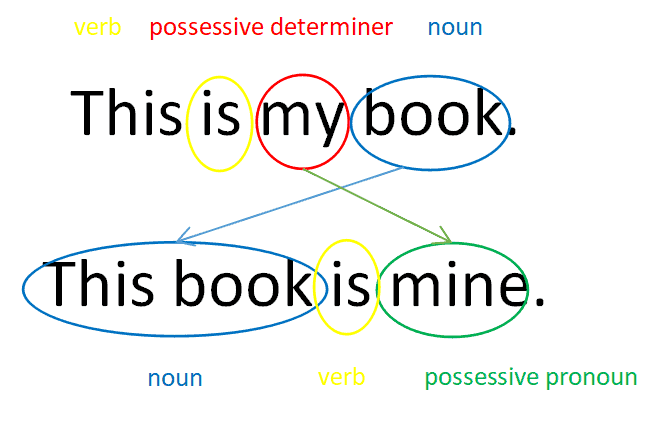
In this blog, you’ll learn how to use possessive determiners correctly in real sentences, match them with subjects, and avoid common mistakes like “its” vs. “it’s.”
You’ll also get examples, clear rules, and practice activities to improve your grammar in everyday, academic, and professional writing.
Let’s dive in.
Key Takeaways
- What are the possessive determiners? Seven essential words that show ownership and identify specific nouns: my, your, his, her, its, our, their
- They are different from possessive pronouns, which replace the noun instead of modifying it.
- Use the correct form based on the subject’s person and number (e.g., “our team” vs. “my idea”).
- Never use apostrophes with possessive determiners. “Its” (determiner) is not the same as “it’s” (contraction).
- Common mistakes include agreement errors, double possession, and incorrect placement.
- Practice through structured exercises helps build accuracy and confidence in real-world usage.
What Is a Possessive Determiner?
What are the possessive determiners? A possessive determiner is a word that shows who something belongs to while pointing to which noun you’re talking about.
The possessive determiners are words like: my, your, his, her, its, our, their.
For example:


Never Worry About AI Detecting Your Texts Again. Undetectable AI Can Help You:
- Make your AI assisted writing appear human-like.
- Bypass all major AI detection tools with just one click.
- Use AI safely and confidently in school and work.
- My dog is sleeping.
- Their project won the prize.
It’s called a “determiner” because it helps identify or “determine” the noun in a sentence. And it’s “possessive” because it shows ownership or a relationship.
What do possessive determiners do?
Possessive determiners clarify ownership, establish relationships between people and objects, and help readers immediately understand which specific noun you’re discussing.
Where They Appear in a Sentence
You’ll see possessive determiners in a few common ways:
- Before a noun
→ my phone, his shoes
(The possessive determiner directly modifies the noun.) - Before an adjective + noun
→ our new house, your funny story
(The determiner still comes first, followed by the adjective and then the noun.)
Possessive determiners can appear in different parts of a sentence, but their position relative to the noun always stays the same:
- As part of the subject
→ Their car is fast.
(Their modified car, which is the subject of the sentence.) - As part of the object
→ I like her idea.
(Her modifies the idea, which is the object of the verb like.) - In prepositional phrases
→ We met at his office.
(His modifies office, part of the prepositional phrase at his office.)
If you’re ever unsure whether a word like her or their is acting as a possessive determiner or a possessive pronoun, Ask AI.

They quickly analyze the context of your sentence and tell you exactly how the word is functioning.
List of Possessive Determiners
Possessive determiners are tied to the subject of the sentence, they match in person (first, second, third) and number (singular or plural). Here’s the complete chart for easy reference.
Example:
- I → my
- You → your
- He → his
- She → her
- It → its
- We → our
- They → their
Let’s break this down by person and number:
- 1st person
Singular: my (→ I)
Plural: our (→ we) - 2nd person
Singular/Plural: your (→ you)
(English uses “you” for both singular and plural) - 3rd person
Singular: his, her, its (→ he, she, it)
Plural: their (→ they)
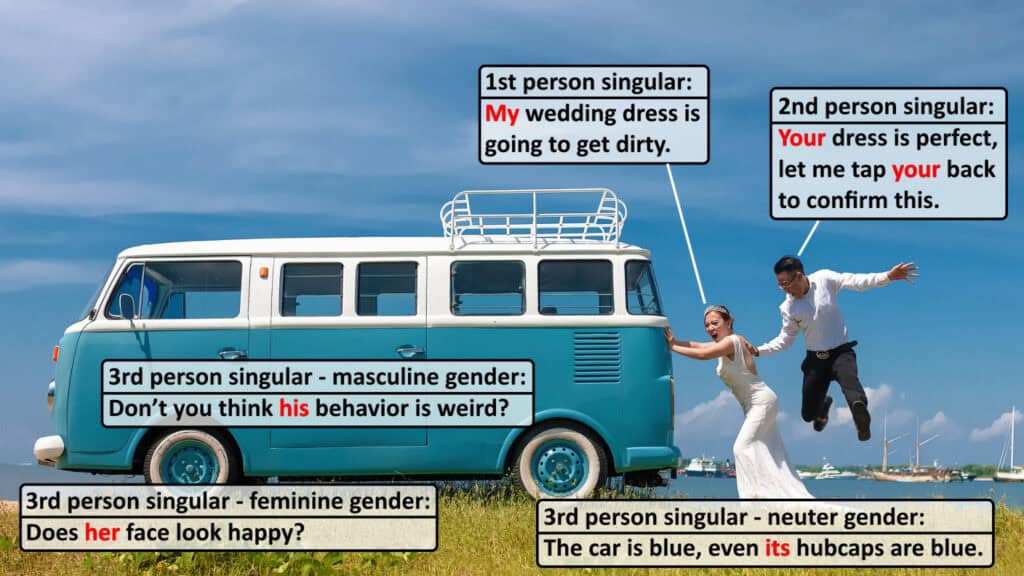
What are 5 examples of possessive determiners?
- My laptop is not working properly today.
- Is this your bag on the table?
- His story inspired everyone in the room.
- She forgot her keys at home.
- The children are playing with their toys in the garden.
None of these words include apostrophes. The word “Its” is a possessive determiner (correct).
If you’re saying “It’s,” it will be the contraction of it is, and incorrect if you’re showing possession.
Matching with Singular and Plural Subjects
The possessive determiner must match the subject in person and number, but the noun it modifies determines the verb agreement and plural logic.
Correct: My dog is hungry. (singular subject + singular noun)
Correct: Our dogs are playful. (plural subject + plural noun)
The key is to focus on who owns the thing (the subject) and what is being owned (the noun).
Example:
- Their house is big.
→ They own one house (singular noun) - Their houses are big.
→ They own multiple houses (plural noun)
“Ours” is a possessive pronoun, not a determiner. You can’t use it before a noun.
Incorrect: Ours teacher is strict.
Correct: Our teacher is strict.
How to Use Possessive Determiners in Sentences
To use possessive determiners correctly, follow this simple, logical process:
Step 1: Identify the owner (the subject)
Ask who owns the noun or has the relationship to it?
- Example: Sarah owns a cat → She → her
Step 2: Choose the correct possessive determiner
Use the subject to find the right match:
- I → my
- You → your
- He → his, etc.
Step 3: Place it before the noun
Possessive determiners always come directly before the noun they modify.
- my idea
- his backpack
- our home
If there’s an adjective, the order is: possessive determiner → adjective → noun
- her new laptop
- their old neighborhood
Step 4: Check for subject–determiner agreement
Make sure the determiner agrees with the subject in person and number, and that the noun following it matches the context.
- Our teacher is kind. (We → our)
- His friends are supportive. (He → his)
To make sure your possessive determiners are correctly placed and agree with the subject, run your sentences through a Grammar Checker.

It can quickly catch mismatches like “ours teacher” or “her ideas is great,” so your writing stays polished and accurate.
To understand the nomenclature of possessive determiners, read this: Possessive Determiner
Possessive Determiners vs Possessive Pronouns
Understanding the difference between possessive determiners and possessive pronouns is essential for writing with clarity and precision.
While they both show possession, they serve very different functions in a sentence.
What’s the Difference?
Possessive Determiners vs. Possessive Pronouns
| Type | Position | Function | Example |
| Possessive Determiner | Before a noun | Modifies a noun | My book, her idea |
| Possessive Pronoun | Stand alone or replace the noun phrase | Replaces a noun phrase | That book is mine |
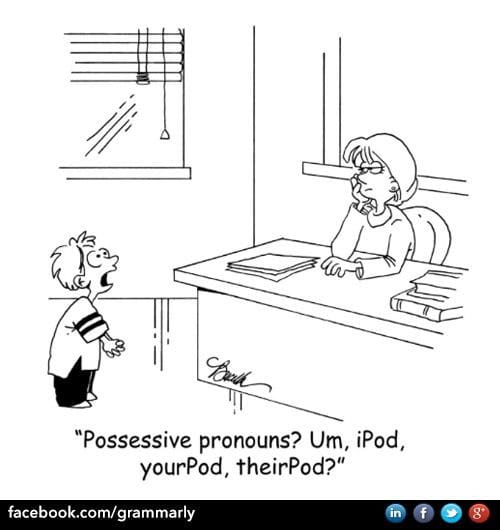
Let’s look at how a possessive determiner transforms into a possessive pronoun:
- my book → mine
- your idea → yours
- his bag → his
- her phone → hers
- our plan → ours
- their house → theirs
If you notice your draft overusing the same nouns or mixing up “your” and “yours,” run it through an AI Essay Rewriter.
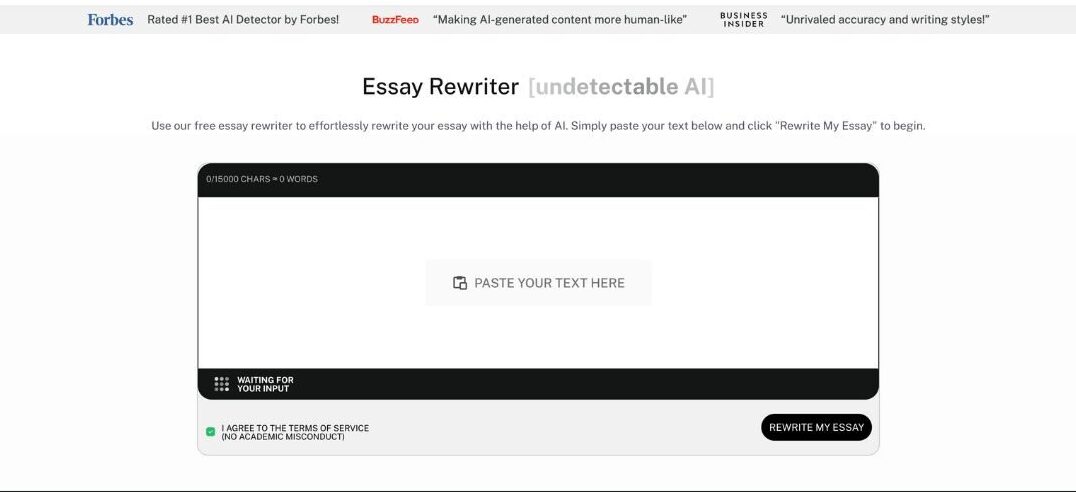
It’ll clean up repeated phrases and make sure your possessives are doing their job without making your writing feel clunky.
“Its” is rarely used as a pronoun. Use it only as a determiner (The dog chased its tail), not standalone.
Also read: What Is a Possessive Pronoun: Simple Guide With Examples
When to Use Each One for Clarity
| Situation | Use This Type | Example |
| When a noun follows | Possessive determiner | My laptop, their car. |
| When standing alone | Possessive pronoun | That one is mine, not yours. |
| Formal writing | Either, depending on role | Our team won. The trophy is ours. |
If there’s no noun directly after the word, use a possessive pronoun. If there is a noun, use a possessive determiner.
Examples in Real Contexts
Here are the different possessive determiners examples so you can understand different styles, tones, and purposes.
Academic Writing
- Her thesis explores renewable energy solutions.
- Their findings were published in a peer-reviewed journal.
- Our study confirms the hypothesis.
- His argument contradicts previous research.
- My analysis focuses on 19th-century literature.
Business Communication
- Please forward your report by 5 PM.
- Our team will review the proposal tomorrow.
- I appreciate your prompt response.
- Their feedback has been noted.
- His presentation exceeded expectations.
Creative Writing
- She clutched her necklace tightly.
- Their laughter echoed through the empty hall.
- My heart sank as I read the letter.
- He reached for his journal in silence.
- Our story began on a rainy night.
Social Media / Informal Contexts
- Just finished my workout!
- Your weekend vibes are unmatched!
- Loving their new album.
- Can’t wait for our trip!
- His meme game is strong.
Technical Documentation
- Insert your password to continue.
- Check our user manual for details.
- Connect your device using the USB port.
- Update their credentials in the admin panel.
- Restart your system after the installation.
Legal / Formal Documents
- Each party shall fulfill their contractual obligations.
- The tenant must pay his rent on time.
- The company reserves its rights in all matters.
- The employee acknowledged her responsibilities.
- This agreement outlines our mutual commitments.
Common Mistakes and How to Avoid Them
Below are the five most common errors related to possessive determiners:
- Confusing its vs it’s
It’s is a contraction of it is, not a possessive.
Correct: The company increased its budget.
Wrong: The company increased it’s budget.
Ask yourself: Can I replace it with it is? If yes, use it’s. If not, use its. Say the sentence aloud replacing “it’s” with “it is.” If it sounds wrong, you likely need its.
- Using Possessive Pronouns as Determiners
Replacing determiners with standalone possessive pronouns is a mistake.
Wrong: Ours team is ready.
Correct: Our team is ready.
Ask yourself: Does the possessive word come before a noun? If yes, use a possessive determiner, not a pronoun. Remember that “my, your, our, their, her, his, its” always comes before a noun.
- Double Possession
Don’t stack two possessives unnecessarily.
Wrong: My friend’s her car is parked outside.
Correct: My friend’s car is parked outside.
Ask yourself: Are two owners being expressed in one phrase? Choose just one form. Use either a possessive determiner or a possessive noun. Never both.
- Agreement Errors
Never mismatch the subject and determiner in number or person.
Wrong: Their class is canceled. (when referring to one student)
Correct: His class is canceled.
Ask yourself: Who owns the noun? Singular or plural? First, second, or third person? Match the determiner to the subject, not the noun.
The noun determines singular/plural; the owner determines the determiner.
- Unnecessary Apostrophes
Apostrophes are never added to possessive determiners.
Wrong: That is her’s book.
Correct: That is her book.
Ask yourself: Does this word already show possession? If yes, it doesn’t need an apostrophe. No possessive determiner ever takes an apostrophe. Period.
Practice Activities
The best way to master possessive determiners is through consistent practice. Below are progressive activity types for correct usage in real-world contexts.
Fill-in-the-Blank (Choose the correct possessive determiner)
Use: my, your, his, her, its, our, their
- I forgot ___ umbrella at home.
- She always writes in ___ journal before bed.
- The dog chased ___ tail around the garden.
- We need to submit ___ reports by Friday.
- Is this ___ phone ringing?
- They brought ___ kids to the picnic.
- He couldn’t find ___ car keys.
- We repainted ___ living room last weekend.
- The bird cleaned ___ feathers on the branch.
- Did you finish ___ assignment?
Error Correction (Spot the mistake and correct it)
- Mine sister is visiting this weekend.
- That cat loves chasing it’s tail.
- Ours teacher gave us extra homework.
- I like hers idea better than mine.
- They packed there bags for the trip.
- Your’s shoes are by the door.
- He brought his’s laptop to work.
- We watched theirs dog play fetch.
- I met her’s brother yesterday.
- The team celebrated it’s victory.
Paragraph Completion
Read the paragraph below and fill in the blanks with the correct possessive determiners: (my, your, his, her, its, our, their)
Last weekend, my friends and I visited a wildlife sanctuary to complete ___ biology assignment. We brought ___ notebooks, cameras, and snacks to stay prepared. James forgot ___ binoculars, so he had to borrow mine. Emily was especially excited because she wanted to observe how the owl cleans ___ feathers during the day. One of the forest rangers showed us a fox and talked about ___ habits and hunting style. We were amazed by how the animal blended into ___ environment. Afterward, we all shared ___ observations and photos over lunch. Have you ever visited a sanctuary for ___ school project?
If we were students, we’d always practice to improve our English grammar. But practice also needs guidance.
That’s where AI Chat comes in.
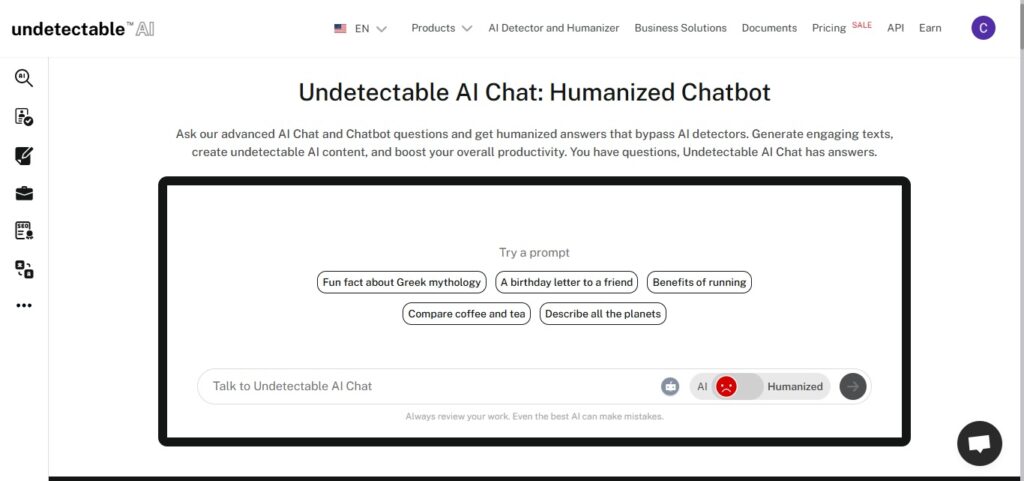
It offers instant feedback on possessive determiner usage or any other grammar topic.
Built for professionals—check and refine your content using the widget below.
Conclusion
Now you understand what are possessive determiners and what do possessive determiners do. What they are, how they work, where they go, and what not to do with them.
If you’ve read and understood the full blog above, you’ll be officially sharper than the average grammar checker.
But grammar mastery isn’t just about memorizing rules—it’s about confidence in your voice.
Whether you’re writing essays, emails, or captioning posts, possessive determiners help make your meaning clear and your sentences smooth.
So the next time someone hands you a messy sentence, you’ll know exactly whose mistake it is, and how to fix it.
And if you’re ever unsure?
Use Undetectable AI’s Ask AI, Grammar Checker, and AI Essay Rewriter—your all-in-one writing coach, always ready to help.
Try Undetectable AI today and turn every sentence into your best work.
